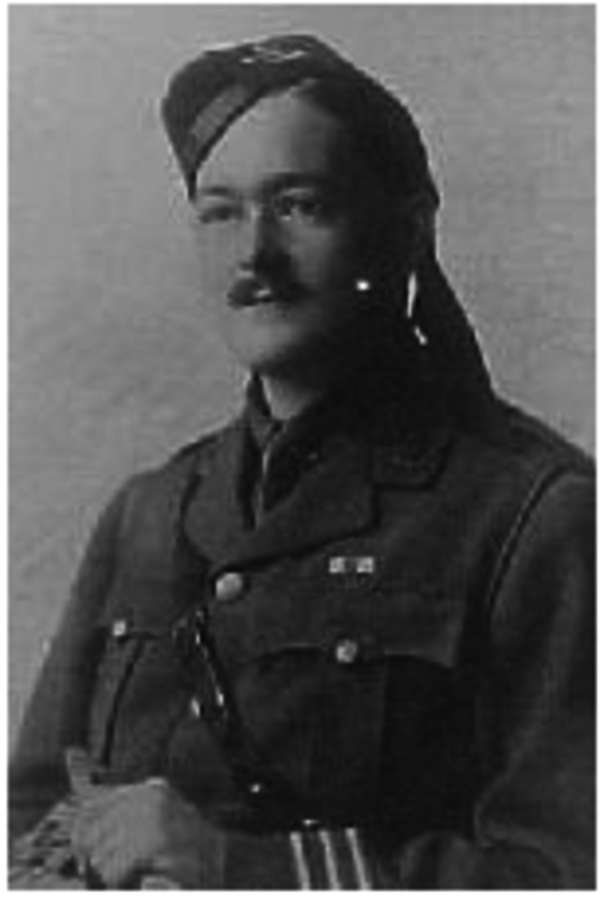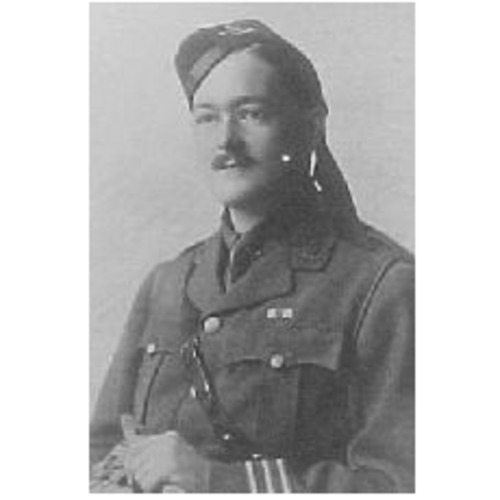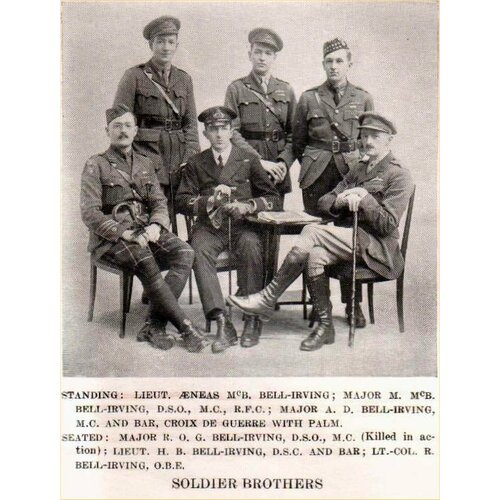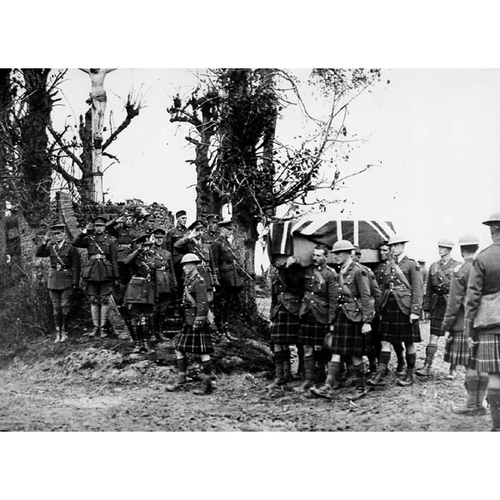
Source: Link
BELL-IRVING, RODERICK OGLE, clerk and army officer; b. 15 Jan. 1891 in Vancouver, third son of Henry Ogle Bell-Irving* and Maria Isabella del Carmen Beattie; m. 9 Dec. 1916 Nora Angela Benwell in London, England; they had no children; d. 1 Oct. 1918 near Cuvillers, France.
Born in Scotland, Roderick Ogle Bell-Irving’s father settled in Vancouver in 1885 and eventually became prominent as a shipping agent, merchant, and salmon canner. Aside from his business interests, he promoted the formation in 1910 of the 72nd Regiment (Highlanders) and took steps to ensure that his children remembered their Scottish background. Roderick was educated at Loretto School near Musselburgh, Scotland. It was natural, perhaps, that after a year in the ranks of the 6th Regiment (Duke of Connaught’s Own Rifles) in Vancouver, he should be among the original group of officers recruited in 1911 for the Highlanders (named the Seaforth Highlanders the next year).
Following the outbreak of World War I in August 1914, Bell-Irving, then a clerk with the shipping and importing firm of Balfour, Guthrie and Company, was part of the contingent of Seaforths who left Vancouver to join the Canadian Expeditionary Force being assembled at Valcartier, Que. On 23 September he was taken on strength there as a lieutenant in the newly formed 16th Infantry Battalion (the Canadian Scottish), which went to England the next month. Before the conflict would end, all of Henry Bell-Irving’s six sons were in the armed forces and two of his four daughters served as nurses.
The 16th crossed over to France in February 1915, but “much against his will” Roderick Bell-Irving was retained at training depots in England until late April. He had been promoted temporary captain on 23 April, following the desperate fighting and heavy casualties of the Germans’ first gas attack at Ypres (Ieper), Belgium.
A year later, in June 1916, Bell-Irving participated with distinction in the battle of Mount Sorrel. When his company was held up at Armagh Wood by enemy machine-gun fire, he found a covered approach to the emplacement. His revolver plugged with mud, he bayoneted three of the machine-gunners and was struggling with the fourth when help arrived. He pushed on with his men to secure his objective, ultimately taking command of both attacking companies of the 16th before the battle ended. Awarded the Military Cross for this action, he had also advanced within the battalion command. He was appointed temporary major on 10 June, while in charge of a company, and acting major on 1 July; this rank would be confirmed on 15 November.
On leave in England from October 1916, Bell-Irving took a course at Aldershot and in December he married Nora Benwell, who had come from Vancouver. Following a brief honeymoon, in January he rejoined his battalion and was appointed second in command. In April–June 1917 he first assumed full command, with the rank of acting lieutenant-colonel, when Lieutenant-Colonel Cyrus Wesley Peck was absent. The 16th took part in the hard-fought battle for Hill 70 in August and later in the battle of Passchendaele. While on the Arras front in France in the spring of 1918, Bell-Irving was mentioned in dispatches.
As it happened, he was in command of the battalion during its last major engagement of the war. Late in September 1918 the Canadian Corps had burst through the German defences on the Canal du Nord west of Cambrai, but it encountered increasing opposition as it attempted to encircle Cambrai. On 30 September Bell-Irving received orders to capture the ground from Sancourt to Cuvillers. The 16th Battalion attacked at 5:00 a.m. on 1 October and took Cuvillers. Bell-Irving, who had been following close behind the leading companies, went ahead to join the men who were exploiting beyond this village. He had scarcely left when the Germans counter-attacked and he was killed. Recovered some days later, his body was buried on 17 October in the British cemetery at Eterpigny, between Cambrai and Arras.
Known familiarly as B.I. and to his family as Rog, Roderick Bell-Irving had been a first-rate soldier. According to fellow officer and battalion historian Hugh MacIntyre Urquhart, “What he thought he said; what he felt, he fought for, and expected others to do the same.” In time, he “grew to appreciate, as did all front line men, the genuine worth of his comrades, their devotion and bravery in times of peril. . . . He would do anything and everything for the men.” In 1919 he was posthumously awarded the Distinguished Service Order. His five brothers survived the war, Alan Duncan, Malcolm McBean, and Richard having achieved distinction in the Royal Flying Corps.
[Information concerning the Bell-Irving family was graciously supplied by Brigadier the Honourable Henry Pybus Bell-Irving of Vancouver, a nephew of the subject, from family records and correspondence in his possession. r.h.r.]
Can., Dept. of National Defence, National Defence Headquarters, Directorate of Hist. (Ottawa), Awards and decorations file. NA, RG 150, Acc. 1992–93/166. Elizabeth [Bell-Irving] O’Kiely, Gentleman air ace: the Duncan Bell-Irving story (Madeira Park, B.C., 1992). H. M[acI]. Urquhart, The history of the 16th Battalion (the Canadian Scottish), Canadian Expeditionary Force, in the Great War, 1914–1919 (Toronto, 1932).
Cite This Article
Reginald H. Roy, “BELL-IRVING, RODERICK OGLE,” in Dictionary of Canadian Biography, vol. 14, University of Toronto/Université Laval, 2003–, accessed April 29, 2025, https://www.biographi.ca/en/bio/bell_irving_roderick_ogle_14E.html.
The citation above shows the format for footnotes and endnotes according to the Chicago manual of style (16th edition). Information to be used in other citation formats:
| Permalink: | https://www.biographi.ca/en/bio/bell_irving_roderick_ogle_14E.html |
| Author of Article: | Reginald H. Roy |
| Title of Article: | BELL-IRVING, RODERICK OGLE |
| Publication Name: | Dictionary of Canadian Biography, vol. 14 |
| Publisher: | University of Toronto/Université Laval |
| Year of revision: | 1998 |
| Access Date: | April 29, 2025 |





